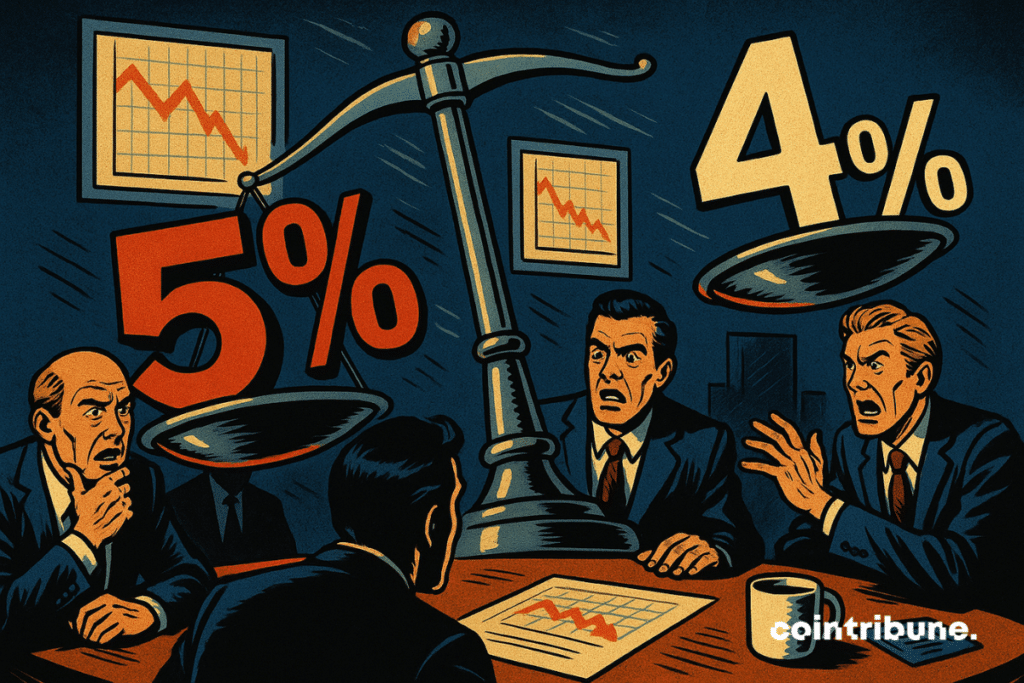17h05 ▪
5
min read ▪ by
Washington is preparing to erase one of the flagship rules established after the 2008 financial crisis. A discreet but decisive reform is about to redefine the foundations of American banking regulation. Indeed, regulators are considering a profound modification of the “supplementary leverage ratio” (SLR), a pillar of post-crash stability. If successful, this decision could upset the financial architecture, with major consequences for the global economy.


In Brief
- The United States plans to relax the leverage ratio imposed after the 2008 crisis.
- This reform aims to free up capital to support the economy and bond markets.
- The SLR currently requires banks to hold 5% equity, unweighted.
- Critics fear a renewed weakening of the financial system in case of a sudden shock.
Why Ease the SLR? Supporters Want to Revive the Economy
For the promoters of this reform, the goal is clear: adapt banking regulation to a new economic reality. The rules imposed after 2008 are considered too rigid in a world where liquidity has become crucial. By easing the SLR, banks could once again support the economy by buying more Treasury bonds, while more easily financing businesses.
This measure is part of the deregulation strategy advocated by the Trump administration. By aligning US standards with those of Europe or Asia, authorities intend to strengthen the competitiveness of national financial institutions.
“Penalizing banks that hold low-risk assets, such as Treasury bonds, compromises their ability to support market liquidity“, stated Greg Baer, director of the Bank Policy Institute. Translation: regulatory barriers must be lifted so that the banking system can play its role during crises.
Furthermore, some experts believe the SLR unnecessarily hinders banks’ agility in an environment where adaptability is vital. “The US Treasury market can freeze during a crisis partly because of the SLR“, warns Darrell Duffie, professor at Stanford.
The message is clear: more leeway means more resilience for the economy.
A Reform That Benefits Banks… and the Economy?
The easing of the SLR breathes new life into major American banks. It would allow them to free up capital to finance activities deemed more productive, directly benefiting the economy. Institutions like JP Morgan or Goldman Sachs see a lever to become pillars of a dynamic financial ecosystem again.
Moreover, this change would encourage the resumption of certain operations abandoned since 2014. Banks could reposition themselves in the public debt market, now dominated by hedge funds and high-frequency traders.
In the long run, this reform could also lower borrowing costs by increasing demand for public securities. Donald Trump sees this as an opportunity to boost the US economy while facilitating the financing of state expenditures. Another alternative to bitcoin and other cryptocurrencies, assets he seems to favor lately.
Many observers also point out that current SLR requirements in the US (5%) are much stricter than in other parts of the world, where they range between 3.5% and 4.25%. Reform supporters therefore see this as a simple rebalancing.
However, positive effects assume careful implementation. The economy is delicate, and every lever pulled can produce unexpected side effects. This gray area is where the debate intensifies.
What is the SLR and Why Was It Established?
The SLR was introduced in 2014. It requires major banks to hold a certain percentage of capital against all their assets, without risk weighting. This rule aimed to prevent the economy from falling back into a crisis like in 2008.
Concretely, here is what you need to remember:
- The eight largest American banks must maintain capital equivalent to 5% of their assets;
- In Europe or Asia, the ratio ranges between 3.5% and 4.25%;
- In times of market stress, this cushion limits chained bankruptcies;
- The ratio is calculated without accounting for the specific risk of each asset;
- Its reform could increase banks’ share in public debt, estimated at 1.8 trillion dollars out of a total of 28 trillion.
But critics do not relent. According to Senator Elizabeth Warren:
These proposals would put our entire economy at risk of another crash paid for by taxpayers.
Translation: the memory of 2008 remains vivid.
As the SLR reform approaches, another decision complements this major move. The Office of the Comptroller of the Currency (OCC) recently authorized American banks to buy, sell and hold cryptocurrencies. This convergence of banking deregulation and openness to digital finance reflects a clear ambition: to strengthen the economic power of the United States in a rapidly changing world.
Maximize your Cointribune experience with our “Read to Earn” program! For every article you read, earn points and access exclusive rewards. Sign up now and start earning benefits.
La révolution blockchain et crypto est en marche ! Et le jour où les impacts se feront ressentir sur l’économie la plus vulnérable de ce Monde, contre toute espérance, je dirai que j’y étais pour quelque chose
DISCLAIMER
The views, thoughts, and opinions expressed in this article belong solely to the author, and should not be taken as investment advice. Do your own research before taking any investment decisions.

